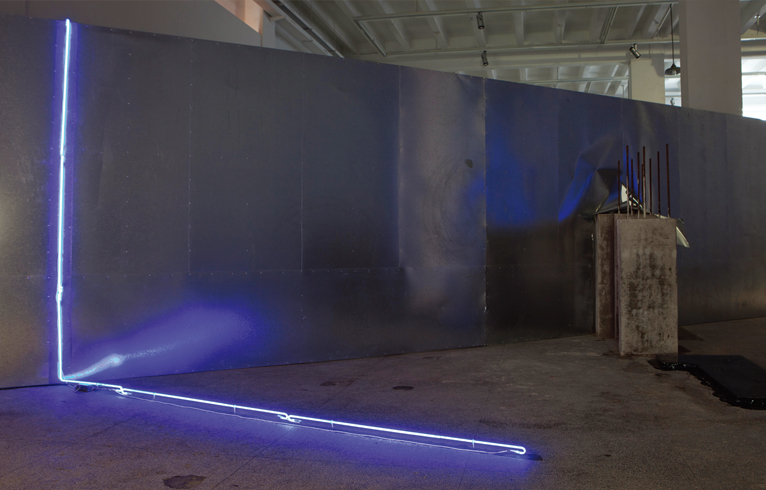HE AN: WHO IS ALONE NOW WILL STAY ALONE FOREVER
| August 9, 2012 | Post In LEAP 15

He An has chosen a decidedly industrial look for his exhibition space, favoring reinforced concrete and viscous engine oil. Commonly found in urban living spaces, these traces of construction sites obscure the realities of a changing landscape. But after the scaffolding and debris are gone, the height and feng shui of the buildings have all changed. Day after day, walking past the thin metal signs that apologize for “inconveniences brought upon by construction” or encourage us to “happily go to work, safely come home,” we filter and ignore the jackhammers, trucks emptying their load, and the pounding of workers. We believe that it has no relation to our lives. For the young people who struggle with the heretofore unseen anxieties of urban life, Rilke’s poem “Autumn Day”— the Chinese translation of which inspired the exhibition’s title— offers a momentary comfort: Whoever has no house now will establish none/whoever lives alone now will live on long alone…
“Please be careful. Don’t step on the artwork,” a young employee warns visitors as soon as they enter the exhibition space. The fair but strong response to touching the edge of the artwork reveals the attitude of the exhibition, the same defensive reaction that people living in cities possess. The left half of the gallery has been sectioned off using sheets of metal, while crushed light bulbs and concrete blocks litter the ground of the right half. Toward the back hangs a vertical neon light, under which is a large puddle of water. These different textures and materials delineate separate spaces, each with its own inviolable boundaries. Subsequently what comes to mind is an idealized conception of the self, one that readily “accepts reality,” and approaches its limits with clarity, while mastering life in the big city. It is a controlled self that exercises command over one’s surroundings and makes judicious use of creativity.
But there are cracks underneath the clear outlines. The artist deliberately left a four-inch gap in the middle of the white sheets of metal. If the visitor leans in close enough, he can see through the gap to another space sectioned off by the sheets of metal. Within it, a dozen white neon light tubes form a triangle, reflected in the pool of black engine oil on the floor. The voyeuristic gap flirts with our perception; it is a gray area, a connector that allows for the resolution of the contradiction between refusal and acceptance. The immense value of this gap derives from our reality, our need to connect to a past— time that was hidden behind the sheet of metal barriers. Looking through it, we achieve an enduring sense of the true.
The alluring pale blue light of neon is patient, affectionate yet mysterious, and ready to lead one into danger at any moment. Yet it cannot withstand the slightest attack; it needs only to rain and the piece will malfunction. In this regard, the neon light is meaningful to everyone. As a replacement for a person or an object, it takes on the interconnectedness between emotion and memory. The neon light easily becomes a transitional object infused with emotion. If the function of light is to illuminate and inspire, we can surmise that the two groups of neon installation in this exhibition are manifestations of the desire for new knowledge, change, and connectivity with the world. I know that to discuss an artist’s preferences for the material is to invite disdain. The important element here is not the object, but how the artist uses objectivity. Perhaps, each time we discuss an artist’s affinity for certain materials, the artist refines his techniques for creating the artworks, like two sides preparing for the next round of hide-and-seek, reaching toward imperceptibility.
Lu Jing (Translated by JiaJing Liu)

